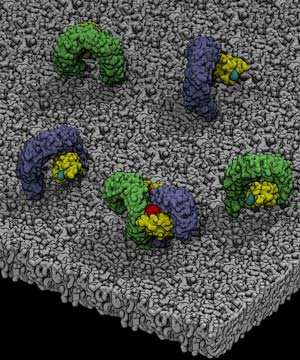Rethinking an inflammatory receptor's obesity connection

Toll-like receptor 4 (TLR4) is a protein that plays a vital role in the body's immune response by sensing the presence of infection. It has long been thought to also sense particular types of fats, which suggested a mechanism linking high-fat diets to the inflammation that is a feature of metabolic disease. However, new research by an international team has undermined that link by showing that dietary fatty acids cannot interact directly with TLR4.
Peter Bond's team, from the A*STAR Bioinformatics Institute, has been studying TLR4 for a long time, looking at how the receptor interacts with a lipid molecule found on the surface of bacteria, called a lipopolysaccharide, and how this can lead to sepsis; a potentially deadly immune over-reaction to infection.
It was believed that dietary fatty acids could also bind to TLR4, and that this was the mechanism underlying the increased inflammation associated with high-fat diets and metabolic disease. However, Bond was skeptical of this.
"It made no sense to me that this receptor would be activated by such dietary fatty acids, because they look very different from bacterial lipids," he says. He was also puzzled as to why such a major component of our diets would trigger this potentially dangerous inflammatory reaction.
He and colleagues hypothesized that TLR4 didn't interact with fatty acids directly, but instead indirectly influenced fat-induced inflammation. To prove this they first had to demonstrate that fatty acids couldn't bind and activate TLR4.
They did this by modelling the possible ways that fatty acids—in particular, palmitate—might bind to the receptor and activate it. The team found that no model allowed palmitate to bind to TLR4 in a stable fashion.
Meanwhile, collaborators Graeme Lancaster from the Baker Heart and Diabetes Institute, Mark Febbraio from the Garvan Institute, and colleagues in Australia were conducting wet laboratory experiments to explore possible interactions between palmitate and TLR4. As with the computer simulations, they found that palmitate was unable to activate TLR4. Subsequent research by the team confirmed the idea that TLR4 influenced fat-induced inflammation indirectly.
The team's theory is that a diet high in fats could change the bacterial populations in the gut, and that this would expose TLR4 to more bacterial components, such as lipopolysaccharides, which in turn could make cells overly sensitive to fatty acids in obese adipose tissue. "The exposure of TLR4 to bacterial components is priming the cells to alter their metabolism and be activated in other ways by these fatty acids," Bond says. "The bacteria themselves are over-activating the immune system and making it more sensitive to fats."
More information: Graeme I. Lancaster et al. Evidence that TLR4 Is Not a Receptor for Saturated Fatty Acids but Mediates Lipid-Induced Inflammation by Reprogramming Macrophage Metabolism, Cell Metabolism (2018). DOI: 10.1016/j.cmet.2018.03.014


















